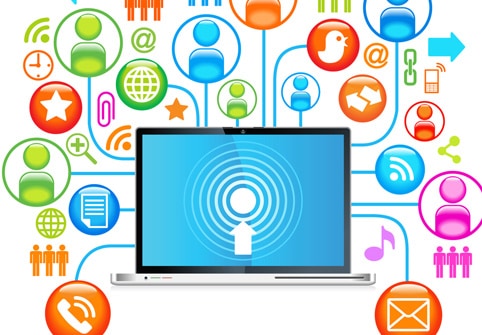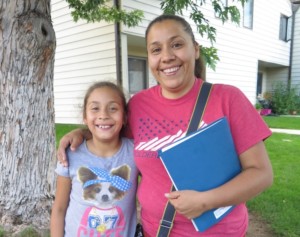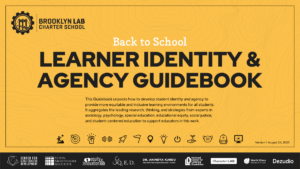Personal Learning Networks for Educators: 10 Tips

By Dr. Mark Wagner
I often begin my workshop on personal learning networks (PLN) for educators by asking these questions: Who is in your learning network? Who do you learn from on a regular basis? Who do you turn to for your own professional development? Some educators are lucky enough to learn from their coworkers or colleagues at their site. Far too many others feel isolated in their room or office, and need to meet with counterparts from other sites in order to have a professional learning experience. All educators (and learners) can benefit from extending their own personal learning network online – beyond the walls of their schools, the boundaries of their districts, and the limits of their experience.
I usually ask these questions at conferences, which are frequently only annual events – and rare treats for many educators. My goal is for workshop participants to leave the session plugged into a global network of like-minded professionals, who will broaden their experience and challenge their thinking on an ongoing basis. I share with participants these ten tips for building their own personal learning network, and I hope these might be useful for you too.
Learning to Network and Networking to Learn
1. Connect – The growth engine of your learning network is your willingness to reach out and make connections with new people. Leave a comment on a blog post or podcast, reply to a question on twitter, or +1 a post on Google+ (or like something on Facebook). Merely reading, listening, or watching is not connecting. The more people you connect with online, the more you can take advantage of the strength of weak ties.
2. Contribute – If you have something to share, post it online where it may be accessible and useful to others. Your expertise (and even your struggles) are valuable to others who don’t have your experience. Anything you create for work (or your own schooling) might as well be shared, and might be valuable to someone else. Making contributions is a way to offer something of value to the new people you are connecting with. Sharing online is even considered a moral imperative by many educators; sharing contributes to the greater good. It’s one way we can pay it forward.
3. Converse – Over time the connections and contributions you make online will evolve into conversations as others respond to you as well. These conversations will in turn grow into relationships, if not friendships. Sharing something about your passions (and challenges) outside of work can also enrich your relationships. Someone you’ve connected with about baseball or raising a toddler might be more likely to respond to your questions about work as well.
4. Request – If you’ve made connections, offered contributions, and cultivated relationships over time… then when you make requests, they are more likely to fall on fertile soil. In circles of educators who connect online, making a request is acceptable and welcome. You’ll find that you’ll receive much higher quality answers and support by asking your network, than you will by simply searching online.
Networking Tools and Anecdotes
The four tips above are the core activities of building a personal learning network, and they can be applied using various tools to connect with others online. Although many other tools, such as wikis, podcasts, instant messages, streaming video, and more can used for connecting this way, the following tools are particularly valuable for building a personal learning network.
5. Blog – Though there will never be another 2004, blogs are still a powerful way for educators (and learners) to connect. Within my first six months of blogging (posting things I had written for work or school anyway), I received comments from six of the authors I had cited in my posts! Over the course of my doctoral research, my blog connected me with more researchers and practitioners than my university ever could have. These trends have continued to this day. If you read many blogs, an RSS aggregator (like Google Reader) can be an essential tool for helping you spend 25% of your time reading and writing blogs for professional development.
6. Tweet – Among educators (and much of the world), Twitter is the most popular social microblogging tool. The posts are short and easy to skim, and because following someone on Twitter is not a reciprocal relationship (unlike friending on Facebook), it is easy to create a custom group of people to follow – and to manage the flow of incoming information. Twitter has been the most powerful tool in the growth of my personal learning network from a half-dozen teachers in the English department lounge to thousands of educators around the globe. Twitter is at least as valuable to me for moral support as it is for technical support. The #lateworkcrew has helped me through many long nights of whittling down my critical tasks.
7. Join Classroom 2.0 – Maintaining a blog and posting regularly to Twitter can feel like significant commitments, and failure to post can generate feelings of guilt. Social networks such as Classroom 2.0, however, are a great place to start with an exiting network (no need to follow, friend, or circle anyone) and with very little pressure to produce. With over 60,000 members, if everyone contributes even a small fraction of what they read, the site is rich with content. For many educators, it is a great starting point for experiencing a personal learning network, not to mention learning more about how these tools are impacting the future of education.
8. Use Google+ – Google’s new social network allows educators to group the people they follow into circles, such as personal and professional (keeping these circles safely separate in a way that is more difficult on other networks such as Facebook). Or, more specifically, users can organize the people they follow into circles for specific subject areas, grade levels, or or even collaborative projects. Additional features are particularly valuable to educators, especially “hangouts” – video calls for up to 10 people, including screen sharing and Google Docs integration. Google+ is also a great tool for expanding your horizons beyond education. There are rich communities of technologists, photographers, and thought leaders sharing on Google+.
Final Thoughts
These final two tips will help keep your initial frustrations in perspective, and help you avoid the temptation to focus on unimportant metrics as you grow your network.
9. Be Patient – Many educators get frustrated when they first experiment with these tools, but building a personal learning network doesn’t happen quickly, and it isn’t a trivial commitment. It takes time to make connections and build relationships. It’s takes perseverance to continue when you receive no replies to your requests, and it requires patience to build up social capitol over the months that may be necessary before you begin to feel part of a community. But it is well worth the investment to one day have a 24/7 global network to tap into whenever you’re in need – or simply want to learn something new.
10. Be Authentic – As Tommy Spaulding says, It’s Not Just Who You Know… it’s how you know them. Despite the appeal of seeing your number of followers grow, or trying to post something you know will generate comments or re-tweets, it is more important to be authentic in your online connections. Don’t try to game the system, worry to much about your online “brand,” or in any way cajole people into following you or responding to you (with contests or incentives for instance). The more you reveal your humanity the more people will trust you, identify with you, and respond to your reflections and appeals. More importantly, the more you seek out the humanity in others, the more they will want to connect with you – and share with you.
Will Richardson, co-author of Personal Learning Networks: Using the Power of Connections to Transform Education has been a part of my personal learning network for years… and I was lucky enough to see him at a conference earlier this week. He shared with me a challenge he recently placed to educational leaders: “If your school system hasn’t changed a year from now, I get it… but if you haven’t changed a year from now, you’re a failure.” I hope these tips might help you start down the road of building your own personal learning network and becoming a more connected learner yourself – or if you’re well down this road already, I hope these tips might be helpful to pass on to your colleagues to get them started. If you have tips of your own for educators just starting to build their personal learning network, or if you have questions as you begin to build yours… please share in the comments below.
Note: For more on this topic, you might also want to explore Jeff Utecht’s book Reach: Building Communities and Networks for Professional Development.
Note: I’ve also been writing about this topic for some time. If you would like to read a brief article that goes into more depth on a few of these points, please see my article Learning to Network & Networking to Learn from The High School Educator in 2008. You are also invited to access the workshop resources for my personal learning networks for educators workshop, which I led as recently as two days before this post.







Pablo Diaz
Great advice and tips! We are about to launch Edmodo as our paperless PLC tool. I am looking into G + as well. Thanks! Pablo
luis
Computers and tablets are only assistants and a good teacher’s will always be needed.
However social networks such as facebook and YouTube as well as great resources including Wikipedia and Wolfram-Alpha are here to stay so that educators must use them in the teaching process.
Some time ago YouTube moved a lot of their educational content to a separate domain giving people access a broad set of educational videos.
However, some complaints include the variety of the content found there as well as the need for schools to register on YouTube under the academic section in order to show their videos, leaving out many academics, professionals and students not formally associated with mainstream schools which contribute with great videos.
Many academics are posting great educational videos and materials online. The only problem is to sort the good ones from the rest and present them in an organized manner.
This effort is being done by: http://utubersity.com which presents the best educational videos available on YouTube in an organized, easy to find way to watch and learn. It also links the videos to related content in Wikipedia or associated websites.
They are classified and tagged in a way that enables people to find these materials more easily and efficiently and not waste time browsing through pages of irrelevant search results.
The website also enhances the experience using other means such as recommending related videos, Wikipedia content and so on. There's also a Spanish version called http://utubersidad.com
Heidi Hutchison
Really helpful information. Right now I am taking part in Will Richardson's Powerful Learning Practice professional development. The most valuable tool I have learned isn't the new tech tools (which I have learned to use many!) but the personal learning networks I have formed. It was good to hear that it does take time and sometimes I do get bummed when I don't get feedback on something I post to Twitter or a blog. I am trying to help my school see the power and the absolute need to get teachers to create these networks but it is slow moving. I have been told I am overwhelming by some collegues because they don't have time to go online. I am trying to have patience but it is so hard sometimes. Thanks for the tips!
Mrs. L
Wow - what a quote from Will Richardson. "If your school system hasn’t changed a year from now, I get it… but if you haven’t changed a year from now, you’re a failure.” We can only choose to change ourselves. So true! I know my teaching is better now than a year ago and I sure hope I can say the same thing a year from now.
Don Breedwell
Thanks for a great listing of the top 10 for PLN's. My wife is an Administrator for K-8 school and I teach Kindergarten in another system. I've been trying to get her hook on PLN's and PLC's and this listing finally did it! Thanks for the great insight and info!
@MrDDon
Daniel Lopez
Another, brand new site (shameless plug right here) for PLCs is Lessonsmith (www.lessonsmith.com). We're trying to create a teacher-focused forum to share lessons, lesson snippets and educational media. We're working to identify the most natural ways for the deep interactions you describe above to occur. I urge you to check it out and give us feedback! We listen and respond to everything and are trying to be 100% teacher-focused!
Paul Miller
Thanks for this Mark. I am new to educational blogging. I started my blig wiifme.blogspot.co.uk only a month ago for both carthartic and developmental reasons. I new it would allow me to get a whole load of my chest whilst at the same time providing shortcuts for othes and me at the same time hopefully by return.
An aim was to make teachers more focussed on engagement of the students rather than the focus being on data production. I hope it is working but it also engaging me more on what I want to see in learning and teaching.
Laura
You make several good points here. As a first step, just reading other's posts is good. However, I like your point that this is not connecting. With technology today, we can connect with people around the world and it's extremely beneficial!
Thanks for a thought provoking article.
Sarah Robinson
I've just started a work-based learning BA after teaching for nearly 20 years, and have suddenly realised how isolated I have been from the wealth of help and knowledge that exists if I can only reach out and connect with others.
Thank-you for such a brilliantly helpful blogpost, in particular the section about "being patient" as now I have the tools I feel like a kid on Christmas Eve...
Mominator
I am working on my Ma in Teacher-Librarianship and just have a toe in the water of Web 2.0. Thank you for giving me some direction to begin!
Judy
I am currently working on my M.Ed. and taking a course that is pushing my technological comfort zone. I am striving to remain calm and not run screaming from the room. Thank you for such practical tips. I will do more research into PLN because it sounds like it is exactly what a colleague and I need. The PLC is no longer meeting our individual learning needs.
I am already thinking about which of my course papers may be appropriate for my very new blog.
Thank you again.
Joan Robinson
Thanks you helped me understand PLNs
Colleen Hartley
We are reading this article as part of a teacher leadership conference!!! How cool is that?? It's through the Arkansas Leadership Academy. I think I'm going to get a Twitter now :)
Judy
great article... I enjoyed all the tips... to the point, useable, and easy to reflect on.
Katherine Better
Yeah! I am so happy I read this article. I sometimes feel I am alone with my cyber problems. Glad to know that there are support groups out there.
There is a solution to every problem.
( Doing the HAPPY dance right now )
Thank you for posting. :-)
Replies
Mary Milligan
The steps were very organized and helpful.
Google is used for a variety of educational purposes and its important to view before using in the classroom.
Vicki LaPrad
A Web 2.0 course assignment I was given included the question "how might you build a network that challenges youthinking and frames of reference?" I am a high school science teacher and this article made me realize that to continue to challenge myself and my students, I should reach beyond my high school colleagues. We science teachers need to collaborate with the researchers, the universities, the leading scientists in our field. That is an ominous thought for me as I sit in my classroom every day. But Web 2.0 has made it possible.
Margaret
Great presentation! I like the last 2 points especially, be patient and authentic.
Thanks
kristie powell
I am consider myself an amateur in using these tools. I didn't realize that these tools could help me expand my teaching methods. I consider myself old school because I looked at tweeting, blogging, and using social media as just having an opinion about anything and everything. I never looked as it as a tool for helping me teach.
Replies
Erik Day
Thanks for the comment, Kristie! Glad to hear you found this helpful. We hope it opens some new doors for you.
Christin Frank
Lots of helpful resources listed here, thanks for the opportunity to explore more areas. The quote listed in the article from Will Richardson, “If your school system hasn’t changed a year from now, I get it… but if you haven’t changed a year from now, you’re a failure.” definitely grabbed my attention. As educators, we owe it to ourselves to continue to grow and learn just like we expect our students to do. This takes time and dedication to our profession to do this but is well worth it in the end.
Cynthia
I think this is very helpful to educators, especially for the upper grades. These will be areas I continue to explore. Every year we are different from the year before, always something new and challenging that educators have to learn each year....so, even if you are one of the "I don't want to" kinda people....you don't have a choice. So, Will Richardson doesn't have to worry! LOL.
Jamie Oliver
These are some very helpful resources for me to use for professional growth. I like having the opportunity to explore options to use technology in my classroom and learn about new ways from other educators to keep my students engaged and learning. I look forward to learning a lot from others.
Mark Johnson
The only network site I have used is the moodle site.
LOU PAGARA
This is very informative and a great challenge for me as a kindergarten teacher. I really enjoy using technology in my classroom, it is effortless and stress free. I wanted to grow technologically. Before, I used google classroom for my 2nd grade class to post homework and classwork. Oftentimes, I use youtube for stories and google sites to search some materials. Thanks for this great information.
LOU P.
This is very informative and a great challenge for me as a kindergarten teacher. I really enjoy using technology in my classroom, it is effortless and stress free. I wanted to grow technologically. Before, I used google classroom for my 2nd grade class to post homework and classwork. Oftentimes, I use youtube for stories and google sites to search some materials. Thanks for this great information.
ShelJ
Very helpful indeed and can be used to improve achievement and meet standards. Sharing ideas online goes beyond boundaries.
Jane Porter
Technology is not a replacement for a counselor. But technology is a great resource for research for a student doing college and scholarship research!
Robert Overby
This was helpful and I think that I will be able to use this to improve my gaining and meeting the desired outcome. Sharing ideas always helps. In person, during class and even online. Thank you.
Kristen
I really enjoyed reading these 10 tips, but even more than that, I enjoyed reading everyone's responses as well. It motivates me to not only continue what I am doing, but helps to push me into learning and applying new ways of helping my students. Which starts by collaborating with others that share the same passion that I have for students and providing the best education I can. I also am motivated to start a blog myself, in order to help share and facilitate other methods of teaching, learning, and growing as an individual and educator.
Richard N Kernodle
Blogs and tweets are just words to me. Twitter is something I have gotten on but I've never really accomplished a network. This article opens my eyes to networking with other teachers, creating and maintaining active conversations with numbers of like-minded people. One can greatly enhance his knowledge and ideas through blogging and twitter.
Debbie Burns
This information was very informative and will be used when required.
Richard N Kernodle
The 10 tips article mentioned Google as one if the networks. G00gle Classroom was immediately available to me as a professional network. It allows for collaboration with students and other teachers and cuts through a lot of teacher red tape.
Juanita Rose
Thanks for the tips and supportive final comments as well as a reminder to be patient. Patience and grace is huge as we all communicate, collaborate, and teach remotely with our colleagues and our students and parents.
Abbie Nordmark
Do you recommend one network over the other for specific grade levels or K-2/3-5? Thank you for the helpful tips! Great article and reader friendly.
Erin Smith
Great starting point for teachers to reach out!